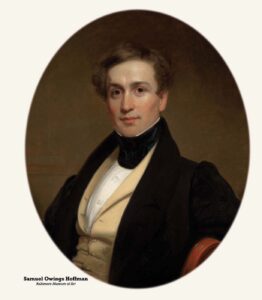

In February of 1858, another group of enslaved individuals attempted to escape. A pair of black men, armed with forged documents by Mr. Campbell, aimed to leave Baltimore behind. They used President Street Station as a waypoint to escape their owners. Samuel Owings Hoftman and Charles Gilmor, Esq. However, Gilmor found out, hailed an officer, and caught the duo before the train left. The police also arrested Mr. Campbell for assisting them.

Samuel Owings Hoffman was recognizable in Baltimore’s economic and political history when this attempted escape occurred in 1850. Born in 1801 and raised in Baltimore, he garnered wealth as the head of a merchant firm and served as Lieutenant Colonel on The First Light Division of Maryland Volunteers. Alter the military, he served on the board of directors for Baltimore Fire Insurance Companv and Baltimore Merchants Bank as early as 1842, alongside Johns Hopkins (before Hopkins became the bank’s president).
By 1850, Samuel Owings Hoffman amassed enough wealth to live on real estate valued at $70,000, according to the 1850 Census (equivalent to about $2.5 million in 2022). In 1856 and 1858. Hoffman served as Baltimore City’s representative in the Maryland State Senate. Afterward. he served on the reception committee for the Constitutional Union Convention of 1860. Baltimore hosted the convention on Mav 9, 1860. When the party selected John Bell and Edward Everett for their presidential ticket. The party’s platform opposed secession but considered no action on slavery.

Hoffman’s history with slavery extends beyond the 1858 attempted escape. The Legacy of Slavery in Maryland website documented the city jail holding an enslaved woman named Lucy Jackson in the summer of 1838. Her listed owner was S. O. Hoffman. Twelve ears later. S. Owings Hoffman appears in the US Census 1850 Slave Schedule with a household of two enslaved people: a 60-vear-old woman and a 35-vear-old man. The pair listed here are like the same brave souls that attempted to flee from Hoffman’s bindings in 1838 and 1858.
Charles Gilmor, Esq.,. was less well-known than Hoffman. However. Hoffman married Louisa Airv Gilmor, the sister to Robert Gilmor, the prosperous merchant and the namesake of Gilmor Street. Robert Gilmor was also the father of Harry Gilmor, the Confederate general and spy arrested during the Pratt Street Riots on April 19, 1861.
There is a probability that Charles Gilmor. Esa. was a relative of Louisa Air Gilmor, potentially explaining how the two enslaved men knew each other and collaborated on their attempted escape. Additionally, their attempt occurred on February 1, 1858, while the Maryland General Assembly was in session, meaning Samuel Owings Hoffman likely was preoccupied in Annapolis. Despite our inability to know their names, we can still acknowledge and reflect on the bravery, organization, and planning these freedom seekers went through to tackle the arduous task of escaping enslavement, and gain assistance from any ally possible on the railroad to freedom.